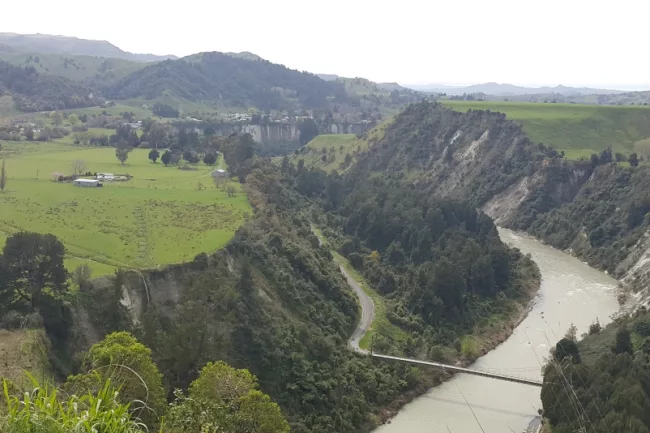History
This is a brief history of how the Rangitīkei began:
The Rangitīkei was one of the first Counties constituted under the Counties Act 1876 when the Provincial system of Government gave place to the County system.
The area was first populated by Ngāti Apa - a proud and aristocratic tribe from the Kurahaupo canoe - with a number of Paa from Onepuhi down to Parewānui about 13 km from the mouth of the Rangitīkei. In the early 19th century they suffered severely at the hand of Te Rauparaha of the Ngāti Toa, and Ngāti Ruakawa, which greatly lessened their power and influence.

Much of the Rangitīkei was a gigantic stand of native bush when the first settlers arrived. During the 1840s a number of settlers made agreements with Māori owners for the settlement of the land within the Rangitikei District. Many travelled up the coast from Wellington and crossed the Rangitīkei River in a ferry operated by Thomas Scott. Without roads, the first settlers were restricted to the windswept coastlands and along the two boundary rivers. In 1849 the Crown negotiated a land sale with the resident Ngāti Apa tribe and Te Rauparaha (who still wielded powerful influence) for the Turakina block through the then Land Commissioner Donald McLean for resale to the settlers. At first, the settlement was along the two rivers, from the Turakina River to Bonny Glen and stretched along the
Rangitīkei River from Parewānui to Pōrewa and Rātā and only later from Pōrewa to Tūtaenui, by 1858 the district was well settled.
In 1868 the coaching days commenced, Rangitīkei's town of Marton became linked by road with Wellington and Whanganui, Cobb & Co coaches travelled twice weekly between these towns. The roads were rough, the bridges and fords many, yet the link was always kept. The first railway was opened in the district in 1878 from Marton to Turakina followed by Halcombe to Marton and Foxton to Whanganui the same year.
By 1884 the road from Napier had reached Moawhango. There had been some progress in the roading from the south. In 1883/4 John Rochfort, a Government surveyor created the route for the railway line from Marton through the upper Rangitīkei and Hautapu districts to Te Awamutu. Rail paid a large part in the early development of the Taihape township, the railway station was completed in 1904, by 1909 there were 23 railway houses.
Adam Glasgow was the first European man to live in the Rangitīkei, living with a Maori tribe in Turakina. In 1841 the Glasgow family welcomed Scotsman Alexander Grant an early settler in Turakina, he was a surveyor from Wellington and New Plymouth before settling in the Rangitīkei.
The first meeting of the Rangitīkei County Council was held in 1877.
Chairman: Alex Milne
Committee: P Bull, D Scot, P Grant, F Lethbridge, R Simpson and N Watt.
The Rangitīkei District Council was the outcome of amalgamation in November 1989 of Marton and Taihape Borough Councils and the Rangitīkei County Council. Waiouru Township was part of the Rangitīkei County Council prior to the amalgamation, it is now part of Ruapehu District Council.
Bulls
For quite some time the site destined to become Bulls township was known as "Daniell's Bush". In 1855 Captain Edward Daniell established "Killeymoon Homestead" in the middle of the area which encompassed the future Bulls and up to Curls bridge. In 1870s early settlers gave the name of "Bulls" to their town, named after James Bull, the carpenter from Chelsea in London who made his way to New Zealand in 1857 and progressed from leasing a 5 acre section from Daniell to founding a whole town. Mr Rangi Reweti was the first Māori member elected in 1968, to the Bulls County Town Committee, although Bulls became a township in 1873 nearly 100 years earlier.
The first meeting of the Bulls Local/Town Board was held in 1873.
Chairman: D E Nathan
Committee: James Bull, J F Shults, N Walker and S Fagan
Marton
The first place to be designated a town was Crofton, a general-store post office was built and the land was subdivided into half-acre sections. These were offered free to any person who built on them within two years. The only stipulation was no liquor was to be sold from any premises erected, thus ensuring a hotel-free township. The Land was finally purchased and laid out for the town of Marton - then known by the Māori place name of Tūtaenui - the name was changed to Marton in 1869 after the birthplace of Captain James Cook.
The first meeting of the Marton Borough Council was held on the 1st September 1879.
Mayor: Fred Beaven
Councillors: W Beckett, S Ingram, J Harris, D Mewett, J Kirkbrids, H Humphrey, W Henderson, C Harrison and S Russell
Taihape
Early settlers in Taihape were never quite satisfied with the name of their village. Originally the area was known as Korohonui, then Collinsville after a Christchurch man named Collins who sponsored a scheme to send a party of Canterbury settlers to the township in 1894. The name of the town was later changed to Hautapu, then Ōtaihape and finally to Taihape.
The first meeting of the Taihape Borough Council was held in May 1906.
Mayor: Anthony Nathan
Councillors: A James, J Sinclair, R Smith, S Beban, W McCormick, W McLennan and W Ellis.
Hunterville
The settlement of Hunterville took place around 1884.
The first meeting of the Hunterville Town Board was held on the 3rd May 1905 when they took over control from the County Council.
Chairman: Mr Remington
Committee: Mr Coltman, Mr Cole, Mr Morris, Mr Ashworth and Mr Street
Approximately 1975 Hunterville became a Community Town, once again operating under the jurisdiction of the Rangitīkei County Council.
Mangaweka
The first meeting of the Mangaweka Town Board was held in June 1910.
Chairman: Mr Georgetti
Committee: Dr Turnbull, Mr Hornblow, Mr Bennett and Mr Officer.
